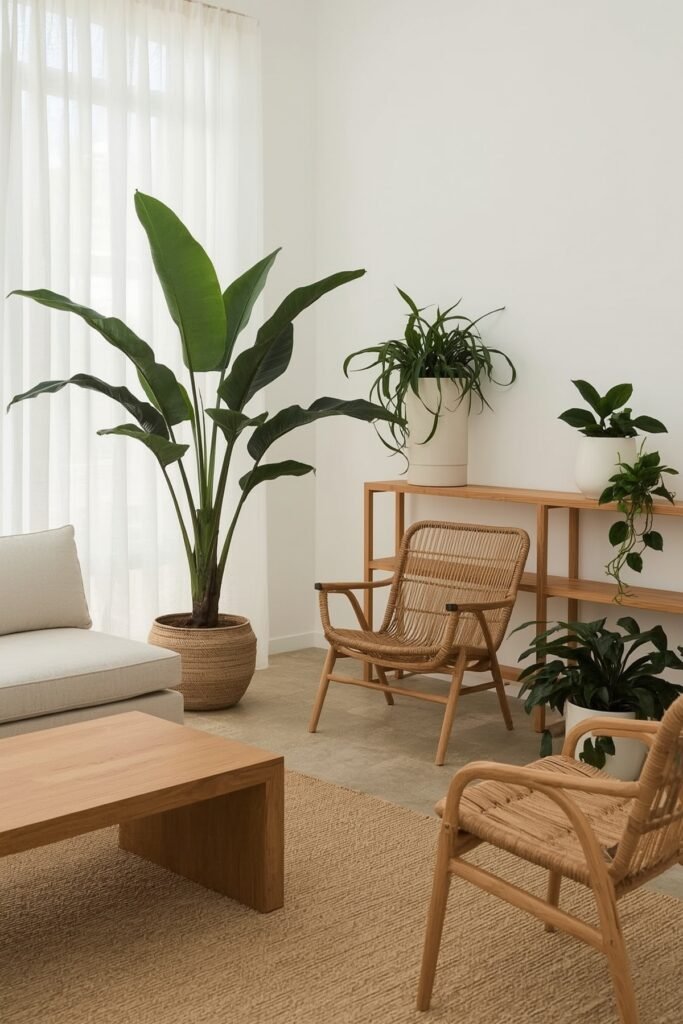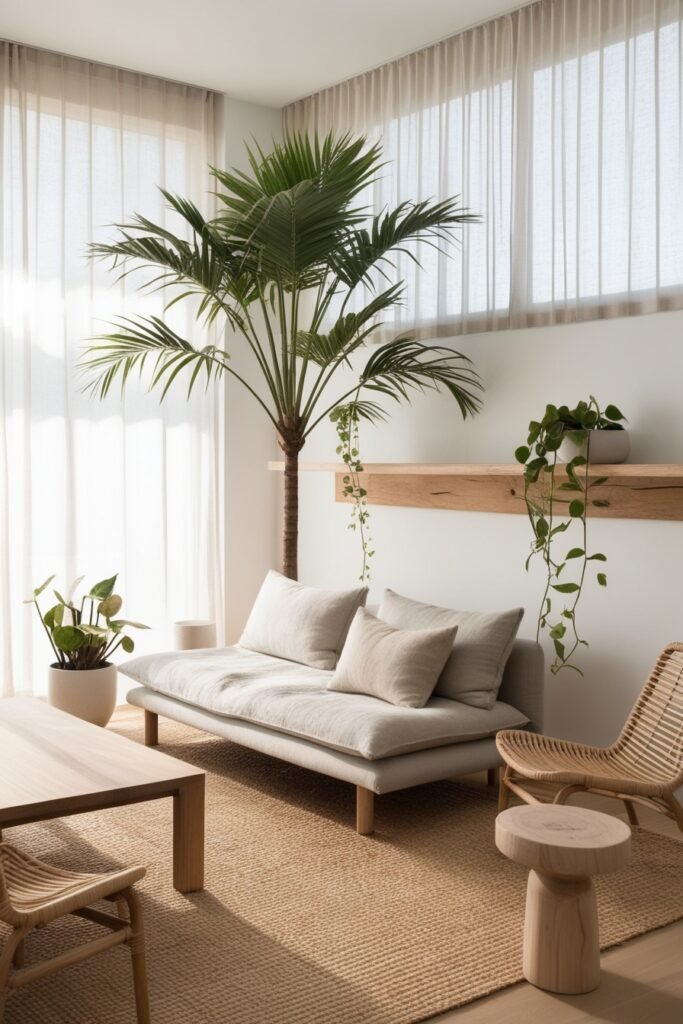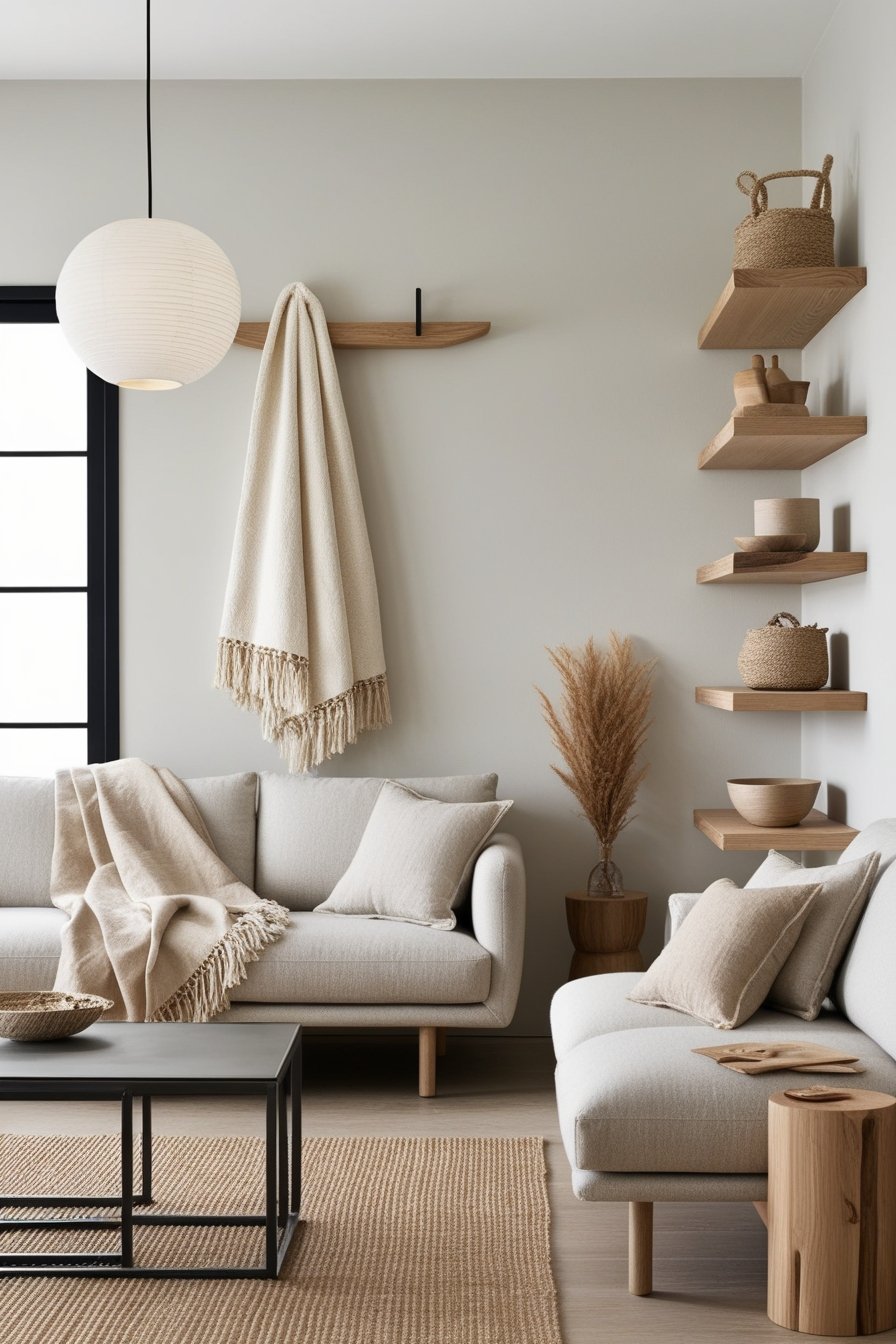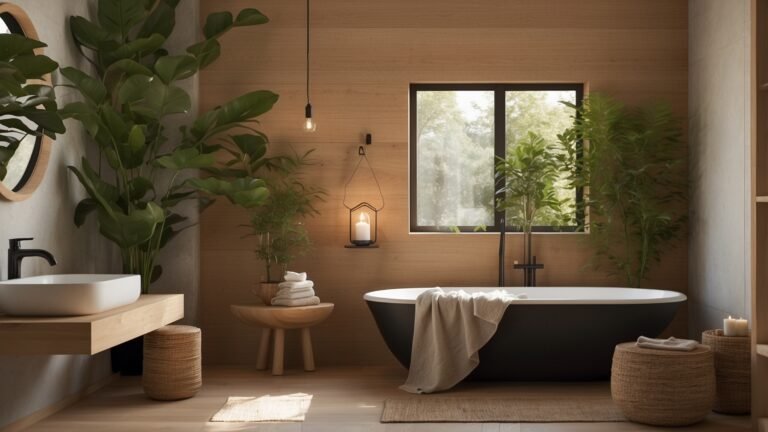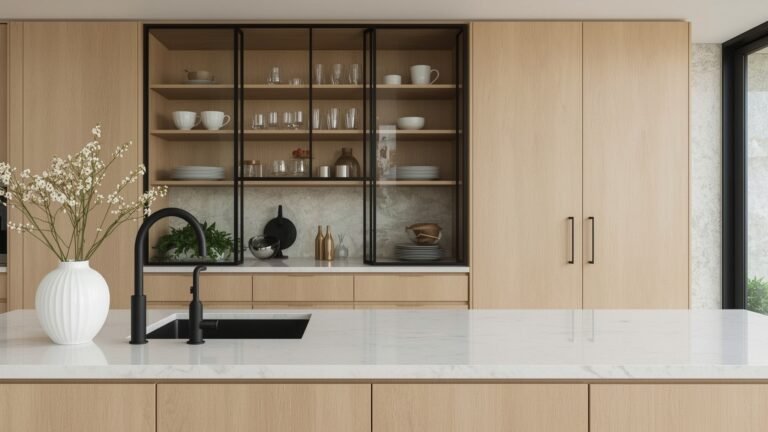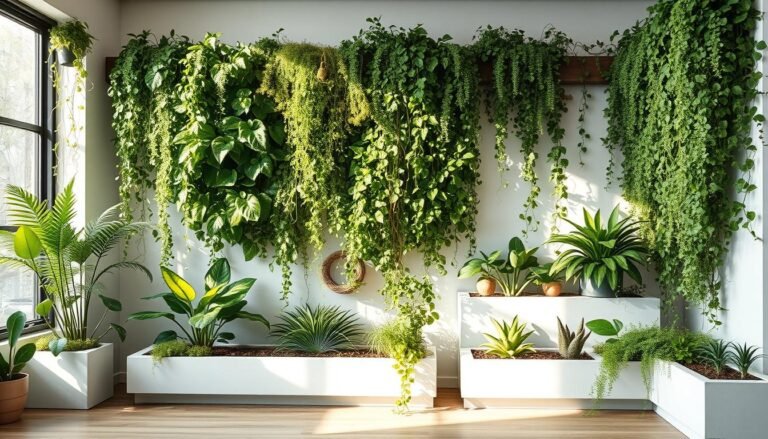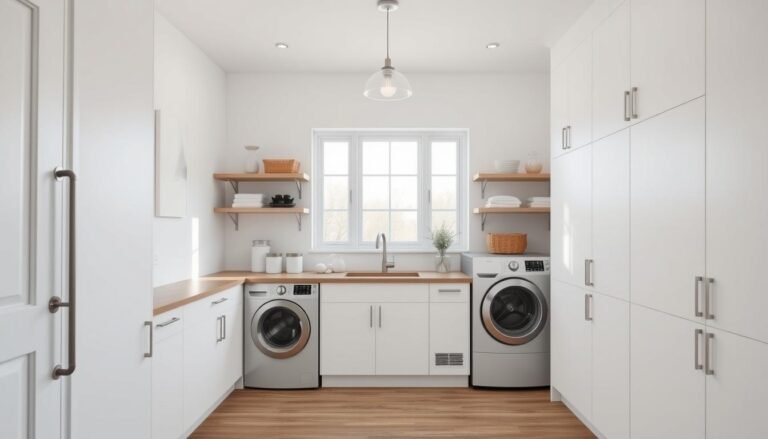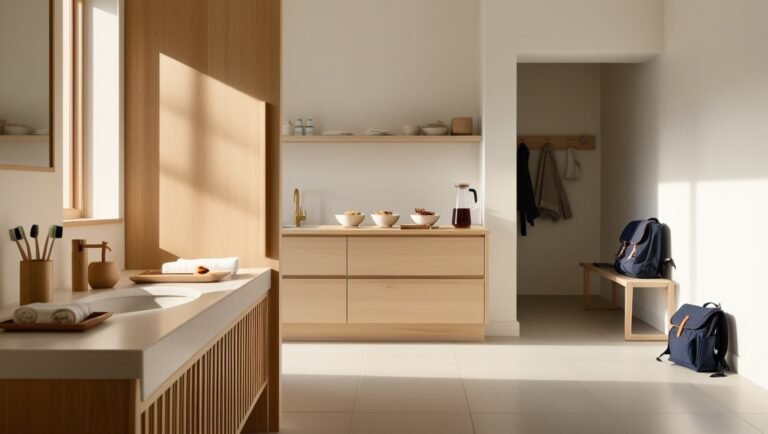Japandi Biophilic Design: Integrating Raw Elements
Do you feel disconnected from nature? Modern homes often focus on looks over calmness. This makes spaces feel cold and empty.
Without natural light or organic textures, rooms can be harsh. Japandi Biophilic Design brings nature inside. It mixes Japanese simplicity with Scandinavian usefulness.
This style uses raw materials like unfinished wood and Ficus Audrey trees. It also includes big windows and limewashed walls. Sustainable choices like reclaimed wood and VOC-free plasters make spaces calm and green.
Key Takeaways
- Expansive windows and skylights maximize natural light and outdoor views
- Raw materials like untreated timber and rough-hewn stone add authentic textures
- Ficus Audrey plants and indoor gardens enhance indoor-outdoor connections
- Sustainable choices like reclaimed wood and VOC-free plasters reduce environmental impact
- Muted earth tones and textured walls foster meditative calm
What is Japandi Biophilic Design?
Japandi design combines the Scandinavian-Japanese fusion of simplicity and function. It takes Japan’s love for imperfection and Scandinavia’s focus on light and space. This mix creates a calm and thoughtful space.
Defining Japandi Aesthetics
Imagine clean lines, neutral colors like pearl grey, and natural wood. Bamboo trays, linen, and raw oak furniture are key. This minimalist biophilic design keeps things simple, using plants and stone to connect with nature.
Spaces feel both open and cozy. They balance Scandinavian warmth with Japanese simplicity. For example, the Raamah Office uses forest green marble and botanical murals. Techspence’s layout lets sunlight in, highlighting potted ferns.
These spaces show Japandi is more than a style. It’s a mindful way to live. It uses materials that age well, like lime plaster and wooden chairs. Every piece tells a story of sustainability and harmony.
The Importance of Nature in Interior Spaces
Bringing nature indoors is more than a style choice. It’s a health priority. Studies show spaces with plants, wood, and natural light reduce stress and boost creativity.
The indoor greenery trend has grown fast. Now, 78% of homeowners use plants like snake plants or pothos for cleaner air. This shows a deep need to connect with nature, after spending more time indoors during the pandemic.
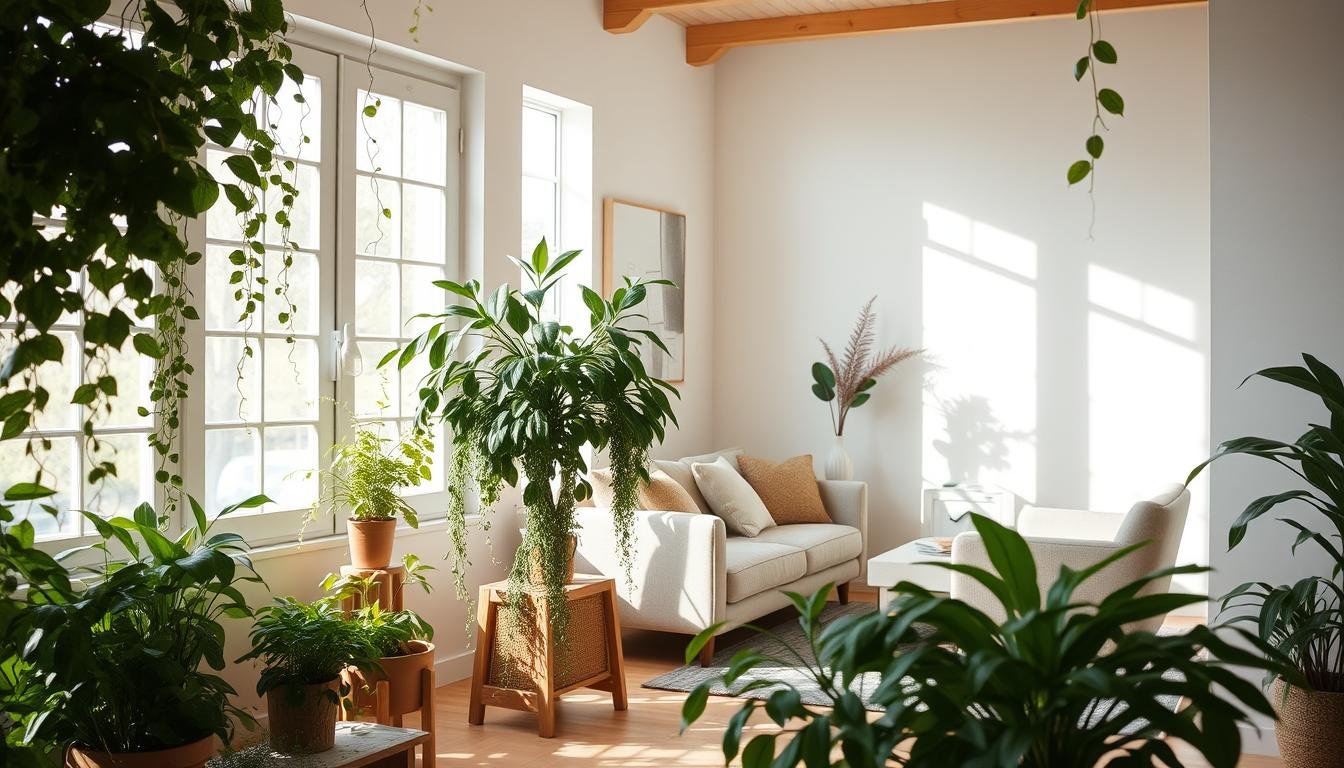
Benefits of Connecting with Nature
Natural light and organic materials like wood or stone make spaces calm. The Eden Locke project uses non-toxic flooring, showing sustainable decor can be stylish and healthy. Plants purify air, and colors like soft greens or warm neutrals improve mood and focus.
Even small details like bamboo decor or water features add tranquility. Biophilic design is not just about looks—it’s science. Research shows natural elements lower anxiety and enhance well-being.
Materials like Atkinson & Kirby’s Noma Smoked Oak flooring are durable and eco-friendly. They align with biophilic principles. By prioritizing these elements, homes become spaces that nurture both body and mind.
Key Elements of Japandi Biophilic Design
Natural materials are key in Japandi style. They mix organic textures with careful design. I focus on materials that feel alive, like wood, stone, and woven fibers.
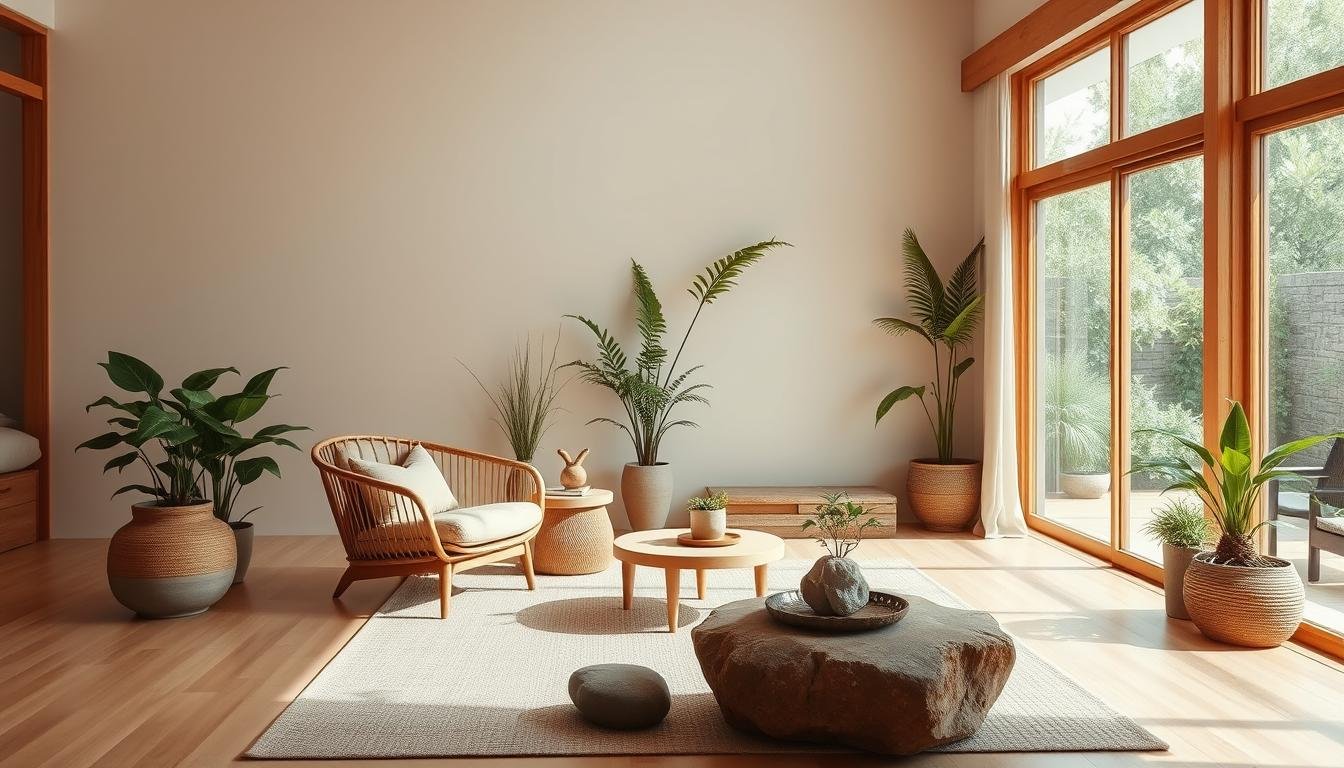
Natural Materials: Wood, Stone, and More
Wood is a big part of Japandi. Light Scandinavian oak or ash meets Japanese walnut or cherry. Handcrafted items like the Hume Stone Coffee Table add warmth.
Rattan and bamboo add flexibility. Clay pots and linen textiles make surfaces softer.
Stone and concrete add weight. They’re used in accent walls or as minimalist vases. Textures like handwoven cotton or flax upholstery add depth.
Every piece has a purpose. A clay vase holds flowers, and a woven basket organizes space.
Choosing FSC-certified wood or local stone is eco-friendly. Even small details, like terracotta planters or wool throws, show sustainability. These materials do more than look good. They connect us to the earth, balancing simplicity with life.
How to Create a Japandi Biophilic Space
Begin by checking your space for spots to add natural elements. Japandi Biophilic Design loves simplicity. Choose materials that connect your decor to nature.
Go for raw textures like woven rattan chairs, raw wood shelves, or terracotta planters. These materials bring the outdoors in while keeping things simple.
Match biophilic elements with Japandi’s simple style. Group plants like fiddle-leaf figs or trailing pothos in one spot. Use sleek ceramic pots to add a touch of elegance.
Add a sisal rug under a low-slung linen sofa for texture. Each item should be useful and beautiful, like storage baskets or a bamboo screen.
Choose pieces that last to keep your space calm. Pick a solid oak coffee table over throwaway decor. Use neutral and earthy tones to keep things peaceful.
Let sunlight shine through sheer linen curtains. It highlights the textures of your materials. Even a small bamboo wind chime near a window can connect your space to the outdoors.
Use raw materials and space them out thoughtfully. Don’t overcrowd, as it messes with Japandi’s clean look. A big potted palm in a corner is more impactful than many small plants.
This balance makes your space feel connected to nature and peaceful in its simplicity.
The Role of Space and Layout in Design
In minimalist biophilic design, open space is more than empty room. It’s key to how we feel in nature-inspired interiors. The Japanese idea of “ma,” or negative space, makes each piece stand out without crowding.
This balance lets natural textures like wood and stone shine. They create a peaceful setting.
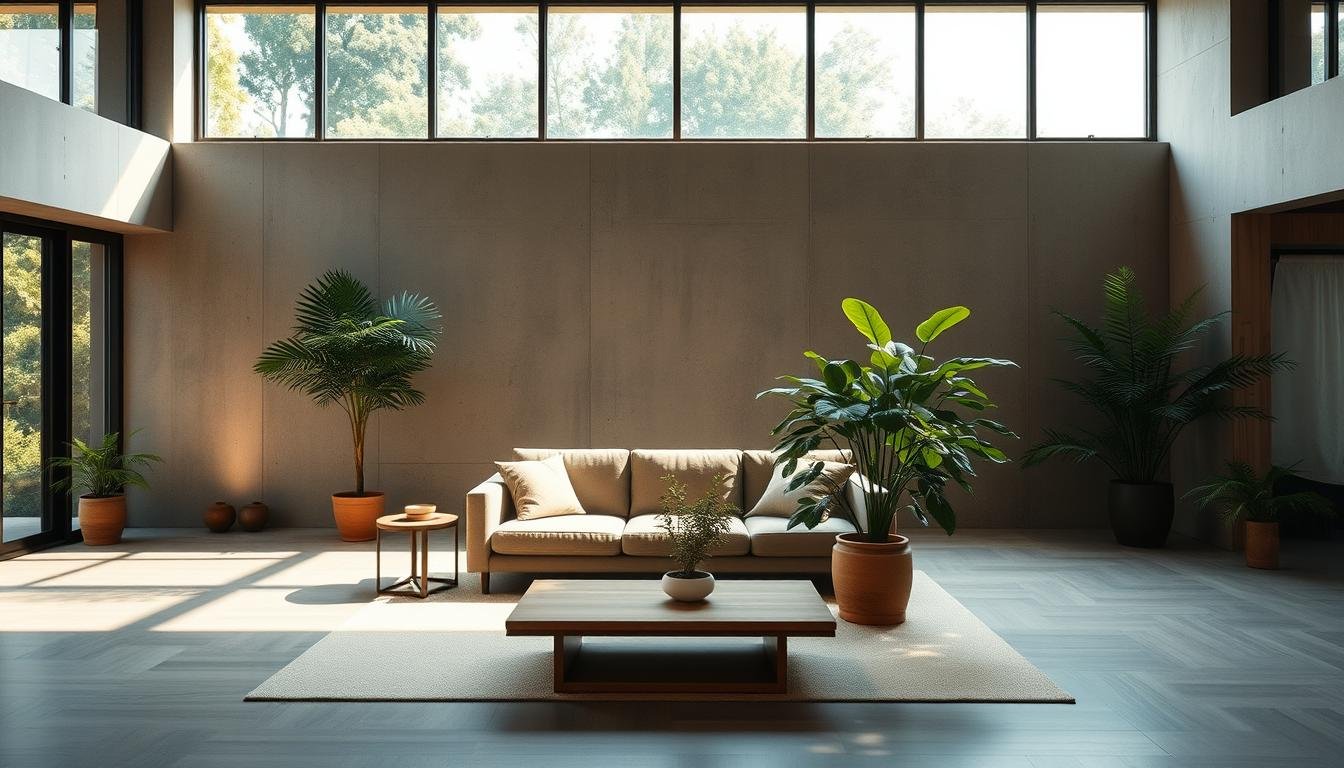
Emphasizing Open Space
Where you put furniture is important. Place it to let people move freely, avoiding tight spots. A live-edge coffee table and a wood slat divider can set up areas without walls.
Items that do more than one thing, like a linen storage bench that’s also a seat, keep things tidy. This fits with Japandi’s simple, purposeful style.
Natural light is great in open spaces, so put plants and mirrors where they can catch it. A big piece of art, like a handwoven tapestry, can decorate walls without taking over. Even in small homes, using modular shelves and vertical gardens adds space and greenery.
Every choice, from a bamboo light to a wool throw, should make the space calm, not chaotic.
Choosing the Right Lighting in Japandi Designs
Lighting is key in setting the mood, and in Japandi design, it connects function with peace. I choose fixtures made from natural materials like wood or paper. This choice fits the minimalist style and is good for the planet. It also makes spaces feel warmer and more serene.
Natural light is essential. Big windows without heavy drapes let sunlight in, helping our bodies and brightening rooms. Mirrors and light surfaces bounce light around, making small areas feel bigger. For artificial light, I pick ceramic table lamps or bamboo pendant lights. They give off a soft glow that keeps spaces calm.
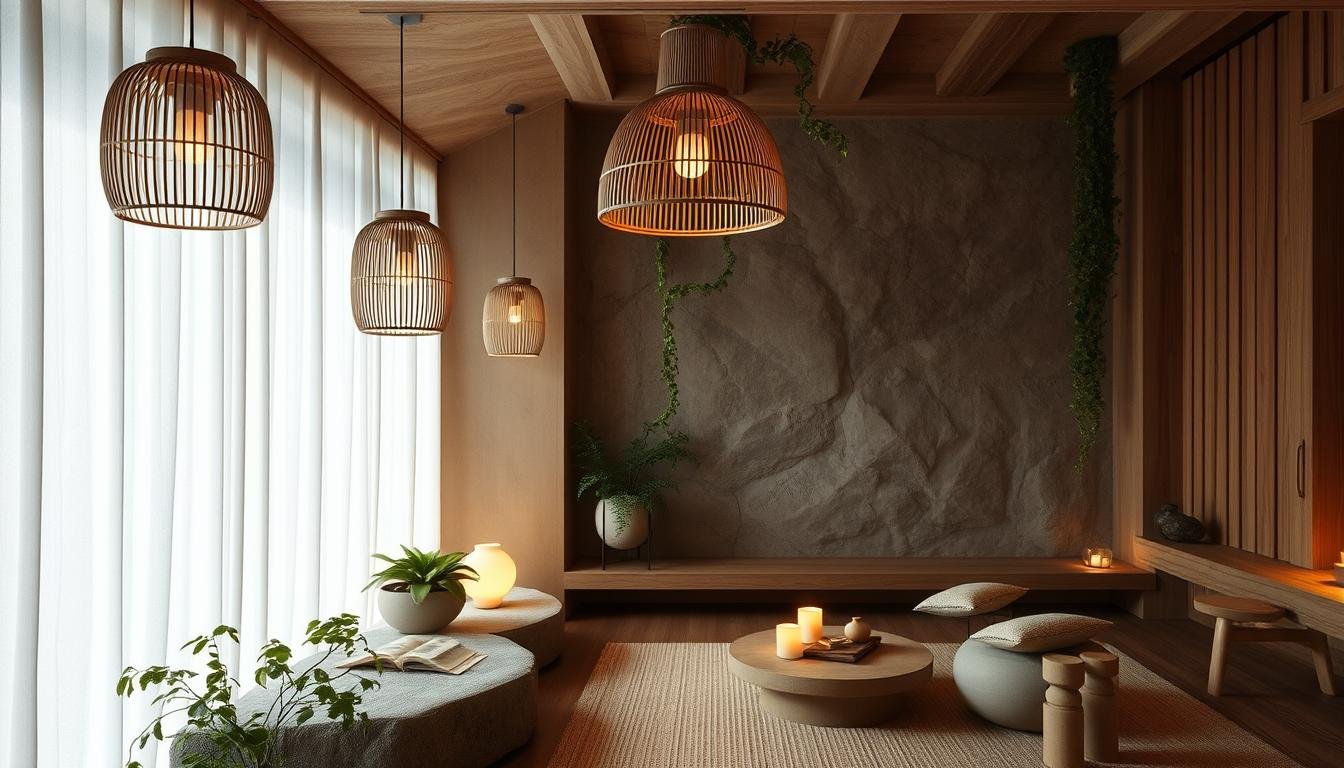
Layered lighting uses different types of lights. A paper lantern pendant adds warmth, while a wooden desk lamp gives focused light. Dimmers help me change the light’s mood. Warm LED bulbs make the light feel like sunset, not cold.
Using materials like rattan or reclaimed wood in lamps adds texture and is eco-friendly. A ceramic floor lamp or woven-shade pendants look organic and cut down on waste. Even affordable options, like a $480 bamboo pendant, can make a space feel natural and stylish. The aim is to create lighting that feels as natural as the space itself, enhancing both looks and comfort.
Sustainable Practices in Japandi Biophilic Design
Sustainability is key in Japandi design. It’s not just an idea; it’s the base. Using materials that care for the planet, I’ve seen how sustainable home decor makes spaces good for the earth.
Reclaimed wood, organic cotton, and natural dyes are at the heart of it. They show that beauty and responsibility can go hand in hand.
Using Eco-Friendly Materials
When picking organic home furnishings, I look for items like the Chinchilla Hammam Throw. It’s made from 300 recycled plastic bottles. The OKU Shelving is built from FSC-certified oak, using old techniques.
The Moon Pendant is made with care for the planet, and the Geometric Pillow uses linen. Even small things, like the Natural Linen Pillow Cover, follow this idea. They use organic fibers and simple designs.
Choosing non-toxic finishes and low-VOC paints keeps harmful chemicals away. LED lighting is energy-efficient, fitting Japandi’s focus on saving energy. The Blade 4 Seater Sofa is comfy and eco-friendly.
Buying items that last, like the Coffee Table’s steel frame, is smart. It means choosing quality over fast trends.
Supporting artisans, like those who made the SIERRA Rug, helps local communities. It also cuts down on carbon footprints. Every choice, from materials to how things are made, shows a love for nature and a wish to protect it.
Personalizing Your Japandi Biophilic Space
In 2025, the Scandinavian-Japanese fusion aesthetic is all about your story. It’s not just about clean lines and muted tones. It’s a base to make a space that feels uniquely yours. My way mixes minimalism with personal touches, showing harmony and individuality can go together.
Begin by picking items that speak to you. A vintage ceramic bowl from a trip, a handwoven basket from a local artist, or a family heirloom can ground a room. Choose items made of natural fibers or reclaimed wood to keep with the biophilic theme. These pieces add warmth without making the space feel too busy.
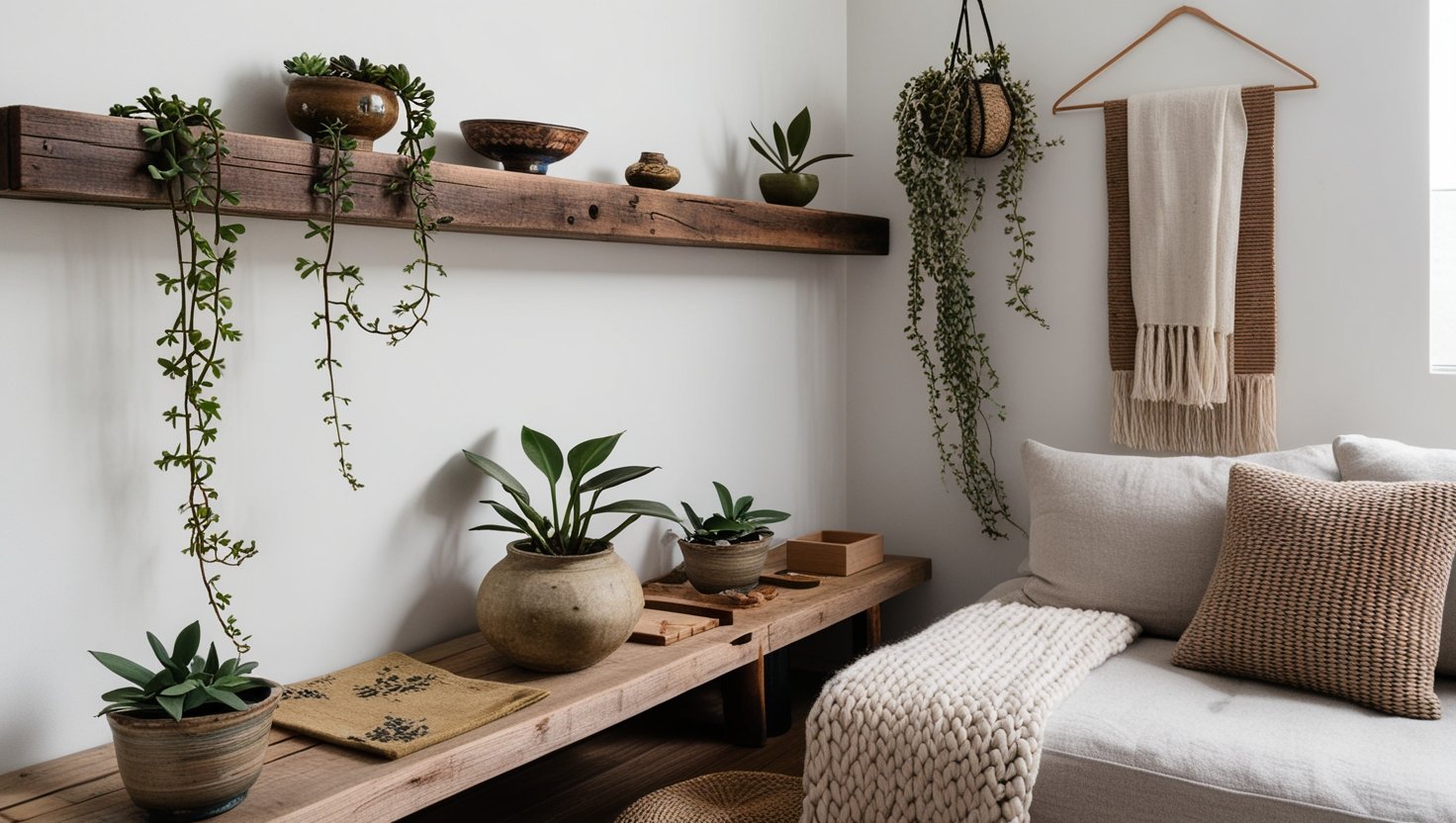
The indoor greenery trend is perfect for making your space personal. Pick plants like trailing pothos or sculptural fiddle-leaf figs to show your love for nature. Group small succulents on a windowsill or train a climbing vine over a shelf. Each choice tells a story of your preferences. Even a single orchid on a desk can make the space feel like home.
Think of rituals as design elements. A corner with a low table and cushions becomes a tea ceremony nook. A wall-mounted hook holding a favorite scarf or hat adds character. Layer textiles in earthy tones but mix textures—a chunky knit throw over a linen sofa—to mirror your lifestyle while keeping the palette cohesive.
Scandinavian-Japanese fusion works best with intention. Let your space grow with you, whether through rotating seasonal plants or displaying new finds. Every detail should feel like an extension of who you are, all while respecting the style’s core principles of simplicity and connection to nature.
FAQ
How does Japandi Design promote wellbeing?
Japandi Design brings nature inside to lower stress and boost mood. It uses green plants and natural stuff to make a calm place for relaxing and being mindful.
What key materials are used in Japandi Biophilic Design?
Key materials include light woods like oak and ash, and darker woods like walnut. Also, stone, rattan, bamboo, and clay are used. They add texture and warmth while keeping things simple.
How can I incorporate Japandi principles into my home?
Begin by adding natural elements to your space. Choose simple decor and focus on quality over quantity. This will help you achieve a Japandi look.
What is the significance of open space in Japandi Design?
“Ma,” or empty space, is key in Japandi Design. It lets natural elements shine. This openness makes the space calm and easy to move around in.
What lighting choices work best for Japandi environments?
Choose natural light, warm bulbs, and fixtures from natural materials. Use different types of lighting to create a peaceful feel.
How is sustainability integrated into Japandi Design?
Sustainability is a big part of Japandi Design. It uses eco-friendly materials like FSC woods and recycled stuff. It also focuses on saving energy to make spaces that are good for the planet.
How can I personalize my Japandi biophilic space?
Add personal touches like family items or travel keepsakes. Make sure they fit Japandi’s simple, natural style. This will make your space truly yours.
The Bottom Line
My journey with Japandi Biophilic Design started with small steps. I added a potted plant here and swapped a synthetic rug for woven cotton there. These changes turned my home into a nature-filled sanctuary.
Japandi Biophilic Design is more than looks. It’s about slowing down and enjoying life’s simple beauty.
Reflecting on My Design Journey
Embracing this style made me love the little things. Like the knots in a reclaimed wood table or the unique marks on a vase. These details add depth and make spaces feel alive.
Starting small is key. A single potted fern or a wool throw can introduce Japandi Biophilic Design. Choosing quality over quantity is important. It shows the style’s focus on lasting beauty and sustainability.
Even in busy cities, adding plants or sunlight-friendly layouts can connect you to nature. This boosts your well-being.
This journey isn’t about being perfect. It’s about making progress. Every change, big or small, brings your space closer to harmony. Let your choices reflect what calms you. Whether it’s a vase of dried grasses or a simple light, aim for a home that grows with you.

ABOUT the AUTHOR
TOKI; INTERIOR DESIGN & lifestyle CONTENT CREATOR.
Hey there! I’m Toki—the design-obsessed brain behind Dwell Studio 24. I’m a content creator passionate about interior design, photography, and creativity, living in a 77-year-old house with my husband and our awesome three kids. I write about interior design, furniture, home topics, and my lifestyle, including travel, recipes, skincare, and daily routines. I hope to inspire your next project and lifestyle!
ABOUT the AUTHOR
TOKI; INTERIOR DESIGN & lifestyle CONTENT CREATOR.

Hey there! I’m Toki—the design-obsessed brain behind Dwell Studio 24. I’m a content creator passionate about interior design, photography, and creativity, living in a 77-year-old house with my husband and our awesome three kids. I write about interior design, furniture, home topics, and my lifestyle, including travel, recipes, skincare, and daily routines. I hope to inspire your next project and lifestyle!
ABOUT the AUTHOR
TOKI; INTERIOR DESIGN & lifestyle CONTENT CREATOR.

Hey there! I’m Toki—the design-obsessed brain behind Dwell Studio 24. I write about interior design, furniture, home topics, and my lifestyle, including travel, recipes, skincare, and daily routines. I hope to inspire your next project and lifestyle!


